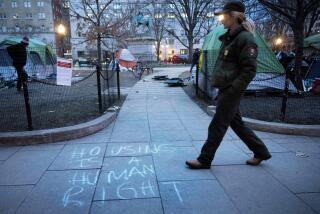D.C. draws up plans for evacuation
- Share via
WASHINGTON — Under pressure from the federal government, Washington and its suburbs are developing their most extensive evacuation plans since the Cold War -- mapping escape routes, stockpiling bedding for shelters and designating pickup points for people without cars.
The area’s preparations for major disasters were deemed “not sufficient” last year in a nationwide study by the Department of Homeland Security. The agency identified problems in coordinating response, evacuation, medical care and the release of information to the public during a terrorist attack or other emergency.
Since then, the capital and suburbs have engaged in a frenzy of planning.
Officials are spending $1.4 million in federal grant money to create a regional evacuation plan, due out this fall. Northern Virginia recently drew up a detailed blueprint. The D.C. area has spent about $3 million in the past year stockpiling blankets, cots and prepared meals.
And the region’s leaders are talking to officials from West Virginia, Pennsylvania and other nearby states on how they could shelter Washington area residents during a crisis. Congress is expected to give the region millions of dollars in the coming months for such planning.
“Not since the Cold War era . . . have you seen this level of aggressive focus” on catastrophic planning in the region, said George W. Foresman, who recently resigned as Homeland Security’s undersecretary for preparedness.
Local evacuation plans differ markedly. The capital and northern Virginia are working on scripts for a possible large-scale flight, but Prince George’s County, Md., wants its residents to stay put. Washington’s plan is public, but Fairfax County, Va., won’t release its version.
Many fear that the already crowded highways and Metro system would be overwhelmed by a significant exodus.
And, with 13 state and local governments in the region -- not to mention a host of federal agencies -- there are questions about who would decide what to tell residents.
More to Read
Sign up for Essential California
The most important California stories and recommendations in your inbox every morning.
You may occasionally receive promotional content from the Los Angeles Times.









